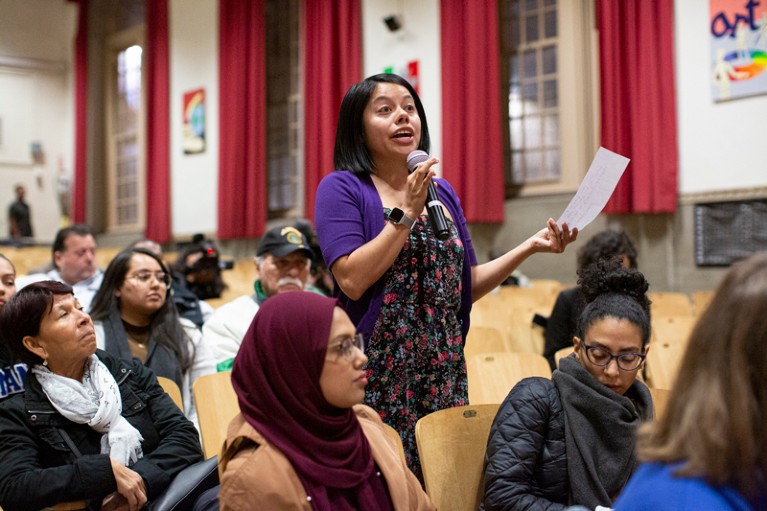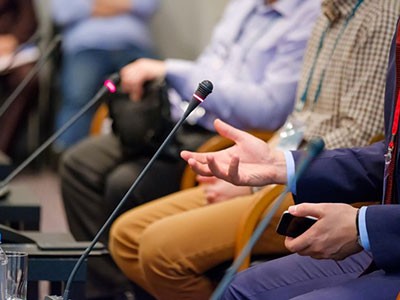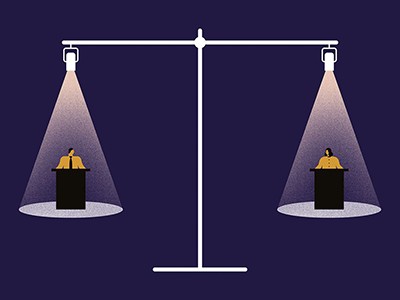
Studies are starting to show that more women participate in conference Q&As when session chairs invite women to ask opening questions after a talk.Credit: Kena Betancur/Getty
At the end of 2019, Nature pledged to work harder to help to address the entrenched gender inequity at scientific conferences (Nature 576, 182; 2019). We looked closely at gender diversity at Nature Conferences (conferences curated by editors of the Nature Portfolio journals), and what we saw was simply not good enough. We introduced a code of conduct, including pledges to have no all-male panels and to invite an equal percentage of women (including all those who identify as women) and men as speakers at all our conferences.
Two years on and these decisions have yielded results. Women comprised 29% of keynote speakers at Nature Conferences between 2016 and 2018 (15 out of 51 speakers across 27 events). That number increased to 48% (14 out of 29) in the 20 meetings that took place in 2020 and 2021.
Nature Conferences: no more ‘manels’
During the same period, women represented 43% of conference organizing committees (59 out of 130) and 51% of speakers for short talks (33 of 65). It’s an encouraging start, but the trends cannot stop there. In 2021, all Nature Conferences were virtual, like almost all other scientific events. It’s early days, but initial reports suggest that online formats can be more inclusive than in-person events (S. Sarabipour eLife 9, e62668; 2020). It is absolutely essential that these modest gains are not reversed once in-person events return.
Best-practice guidance is being refined all the time. The advocacy group 500 Women Scientists is working with several major scientific organizations, including the Aspen Global Change Institute, the American Geophysical Union, Colorado State University, the Earth Science Women’s Network, Georgia Sea Grant and the team behind the virtual seminar series Pal(a)eoPERCS, to update their inclusive scientific meetings guide (see go.nature.com/3ilz3e5). The guide aims to share good practice, including tools to help ensure that events are more inclusive. Nature Conferences will strive to use these tools, and we hope that other conference organizers will too.
Data from the UK Society for Endocrinology’s annual national conference are the latest to show that even when meetings have roughly equal numbers of male and female delegates, women attendees participate less and tend to ask fewer and shorter questions (V. Salem et al. Lancet Diabetes Endocrinol. 9, 556–559; 2021). A simple intervention improved things: when conference organizers were asked to have more female session chairs, and those chairs were asked to invite opening questions from women wherever possible, questions from women rose to 35%, from 24% the previous year.
How to banish manels and manferences from scientific meetings
“If women are not visible at conferences, they cannot act as role models for junior academics, creating a self-perpetuating cycle,” the paper’s authors point out. Nature’s insistence on gender parity, where possible, at its conferences is just one step towards encouraging more women to take part in their communities’ discussions.
Codes of conduct for scientific meetings, such as that introduced by Nature Conferences and others before us, are crucial. They are becoming the norm, with many large learned/academic societies making commitments to improve diversity across their activities — and there are encouraging signs that they are starting to pay off.
Codes of conduct need to be enforced, and there need to be checks in place to ensure that they are followed and that they continue to be effective at truly improving diversity — not just in attendance, but in participation, too. We also acknowledge that our efforts need to be broader, and not focused solely on gender.
There’s a very long way to go to achieve full equity, inclusion and diversity at scientific conferences. The Nature journals are committed to achieving inclusivity for the good of science and society. We are proud to have made a small change and understand and accept that there is much more that we can and must do.

 Nature Conferences: no more ‘manels’
Nature Conferences: no more ‘manels’
 Nature’s under-representation of women
Nature’s under-representation of women
 How to banish manels and manferences from scientific meetings
How to banish manels and manferences from scientific meetings
 Women from some under-represented minorities are given too few talks at world’s largest Earth-science conference
Women from some under-represented minorities are given too few talks at world’s largest Earth-science conference





